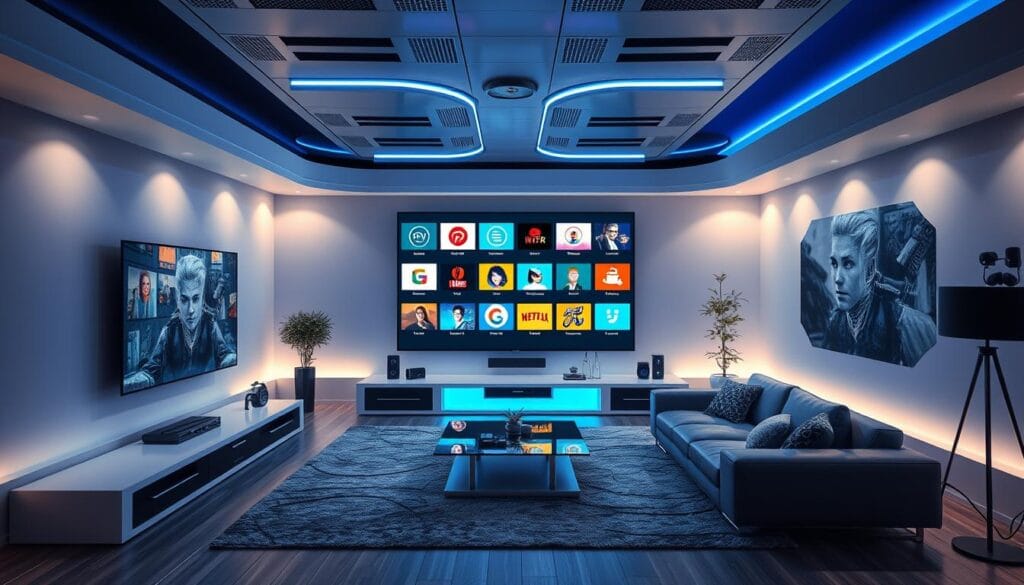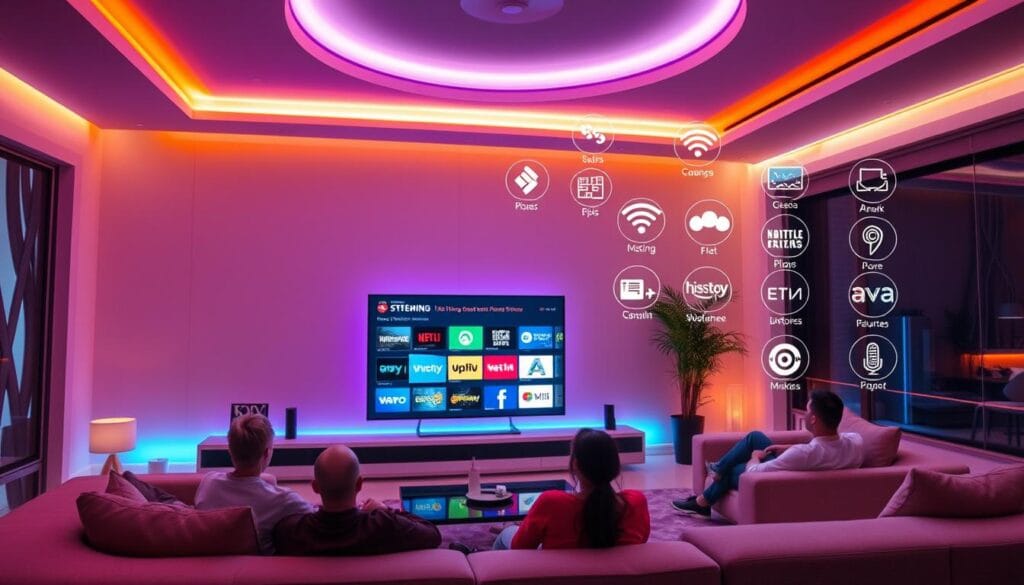As we near 2025, TV watching is changing fast, thanks to IPTV (Internet Protocol Television). IPTV trends are set to lead the streaming market. This is because people want more flexibility and better viewing quality.
Studies show a big increase in subscribers. New tech makes getting content easier, making IPTV top choice for many. Also, future tech improvements will make IPTV even more important in our lives.

Key Takeaways
- IPTV is increasingly preferred due to its flexibility and on-demand viewing.
- 2025 is projected to see significant subscriber growth in the IPTV market.
- Technological advancements are enhancing streaming quality and accessibility.
- The best IPTV service provider will emerge through innovation and user experience.
- Data-driven trends highlight the shift towards digital content consumption.
Introduction to IPTV and Its Evolution
IPTV changed how we watch TV. It started in the early 2000s when the internet got faster. This led to a move from old cable TV to IPTV, starting a new broadcasting era.
Big steps like high-definition and 4K streaming made watching TV better. Companies like AT&T’s U-verse and Verizon’s FiOS updated their services to meet new needs. IPTV’s flexibility and reach helped it grow fast.
Reports show IPTV is getting more popular. People like watching what they want and getting content tailored to them. This IPTV evolution shows a shift towards a modern TV experience, changing how we watch.

| Year | Key Development | Impact on IPTV Adoption |
|---|---|---|
| 2002 | Launch of first IPTV services | Initiated interest in internet-based TV |
| 2006 | Introduction of HD streaming | Increased subscriber numbers |
| 2012 | Expansion of service providers | Broader market competition |
| 2019 | Growth of 4K streaming | Enhanced viewing experiences, higher adoption rates |
| 2023 | Emergence of cloud-based IPTV | Greater flexibility and user engagement |
Overview of Current IPTV Trends
The IPTV world is always changing, with new trends leading its growth. One big change is the move towards bundled services. Many providers now offer internet, phone, and IPTV together in one package. This meets customers’ desire for convenience and value, boosting IPTV’s market size.
Improving the user experience is key, pushing for more personalization and easy-to-use interfaces. Roku and Apple TV have made their platforms better, making it easier for users to enjoy content. This helps keep subscribers and encourages them to try more.

Mobile streaming has changed how people watch TV. More people are watching on smartphones and tablets. Providers are now making their services more accessible and flexible, matching what viewers want.
| Trend | Description | Impact on Market Growth |
|---|---|---|
| Bundled Services | Integration of IPTV with internet and phone services | Increased subscriber base and revenue |
| Personalization | User-friendly interfaces and tailored content suggestions | Enhanced user engagement, leading to loyalty |
| Mobile Streaming | Growing viewership on smartphones and tablets | Broader reach and flexibility for providers |
Understanding Streaming Technology
Streaming technology is key to modern digital entertainment. It lets users watch a wide range of content live. Knowing how it works is important for understanding how it changes how we watch and what services offer.
Key Components of Streaming Technology
Several important parts make streaming work well. These include:
- Codecs: Tools like H.265 make videos look better while using less internet.
- Protocols: Systems like RTMP and HLS help data move smoothly.
- Bandwidth: Enough internet speed is needed for streaming without breaks, especially for high-quality videos.
Future Developments in Streaming Technology
Streaming is set to get even better with new tech. The biggest change is coming from 5G. It promises faster speeds and less delay. Tests are underway, showing us what’s next for streaming.
The Rise of Internet Television
Internet television has changed how we watch media. More people are choosing digital streaming over traditional TV. They like the flexibility of watching what they want, when they want.
According to Nielsen, cable TV subscriptions have dropped. But streaming services have seen a big rise. This shows people want content they can watch on their own schedule.
People want to watch their favorite shows and movies whenever they want. This demand has led to more content on Netflix, Hulu, and Amazon Prime Video. This makes internet TV even more popular.
| Year | Cable Subscriptions (Millions) | Streaming Subscriptions (Millions) |
|---|---|---|
| 2019 | 90 | 30 |
| 2020 | 85 | 40 |
| 2021 | 78 | 55 |
| 2022 | 72 | 70 |
| 2023 | 65 | 85 |
This trend shows internet TV is becoming the norm. As technology gets better, our connection to media will grow. This will make watching TV even more engaging.
Video on Demand: A Game Changer
Video on Demand (VOD) has changed how we watch TV. Services like Netflix and Hulu let us watch shows whenever we want. This change has made watching TV more flexible and has changed how we watch.
Consumer Preferences for Video on Demand
More people want VOD because it lets them choose what to watch. This is different from traditional TV, which has set times. Young people especially like binge-watching and having access to lots of movies and shows.
Impact on Traditional TV Services
More people are choosing VOD over traditional TV. Young adults are leading this change, preferring VOD over cable. This makes it hard for traditional TV to keep up, forcing them to change how they offer shows and market themselves.
| Viewing Preference | Video on Demand | Traditional TV Services |
|---|---|---|
| Accessibility | Anytime, anywhere | Set schedule |
| Content Variety | Extensive library | Limited selection |
| Binge-Watching | Supported | Not applicable |
| Subscription Flexibility | Various plans | Long-term contracts |
Digital Entertainment and Its Growth
The world of digital entertainment is always changing. This is because of new technology and what people want to watch. Now, more people want to watch stories and experiences whenever they want.
Trends in Content Consumption
More people are binge-watching shows. They like to watch many episodes at once. This change has made Netflix and Hulu change how they release shows.
This change shows how important quality is. It’s more important than how much content there is.
Industry Responses to Digital Entertainment Growth
As digital entertainment grows, companies are changing how they work. Amazon Prime and Disney+ are making more original shows and movies. They want to offer unique stories and stories from different cultures.
This shows a big change in the industry. Producers now know they need to offer new and different content.
Live Streaming Services: What’s Next?
The rise of live streaming services has changed how we watch content, especially in gaming and sports. Sites like Twitch and YouTube have seen huge increases in viewers. This trend is expected to keep growing, bringing new chances for creators and viewers.
Being able to interact with what you’re watching is key to better viewer experiences. As tech gets better, we’ll see more ways for viewers to join in live. This will make watching live events more fun and engaging.
The table below shows important details about the top live streaming platforms:
| Platform | Primary Focus | Viewer Engagement Techniques | Average Daily Viewership |
|---|---|---|---|
| Twitch | Gaming | Chat interaction, Polls, Subscription incentives | 2.5 million |
| YouTube Live | Various content | Live chat, Super Chats, Community posts | 500,000 |
| Facebook Gaming | Gaming | Watch parties, Comments, Reactions | 300,000 |
| DLive | Content creation | Live donations, Community building | 100,000 |
As more people want live streaming services, the industry must keep up. We can expect better technology soon. This will make live streaming even more fun and interactive for everyone.
Cord-Cutting Trends Among Consumers
The move towards cord-cutting is changing how we watch media. More people are choosing over-the-top (OTT) services over traditional cable. This change affects both homes and the cable industry.
Studies show that younger people, especially those 18 to 34, are leading the way. They prefer streaming over cable. Older folks, however, tend to stick with cable, valuing its content and reliability.
This trend shows a shift towards personalized entertainment. People want to pick what they watch. Cable companies are trying to keep up by offering bundles, better prices, and improved service.
- Shift in viewing habits towards on-demand programming.
- Increased interest in subscription-based streaming platforms.
- Competitive pricing strategies becoming essential for traditional cable companies.
The future of watching entertainment is changing. As more people cut the cord, how we get and watch content will keep evolving. This will affect different groups in different ways.
OTT Platforms and Their Impact on IPTV
OTT platforms like Netflix, Hulu, and Amazon Prime are changing how we watch videos. They are making a big impact on IPTV providers. These providers must now adapt to stay ahead in the market.
The Role of OTT Platforms in Content Delivery
OTT platforms offer benefits that traditional IPTV can’t match. These benefits include:
- Subscription models: They have flexible pricing for different budgets.
- Content variety: They have a huge library of original and third-party content.
- User interface: Their interfaces are easy to use, making watching videos a breeze.
- Accessibility: You can watch on many devices, anytime, anywhere.
This has pushed IPTV providers to improve. They’re using new technologies to make their services better. They want to attract viewers who like the flexibility OTT platforms offer.
| Feature | OTT Platforms | IPTV Providers |
|---|---|---|
| Subscription Cost | Flexible models | Fixed packages |
| Content Library | Extensive and varied | Limited and genre-specific |
| User Experience | Simplified | Traditional navigation |
| Device Compatibility | Multi-device access | Device-dependent |
This competition shows IPTV providers need to innovate. They must meet viewer demands in the OTT era.
IPTV Trends: Looking Ahead to 2025
The world of IPTV is changing fast, with big things expected by 2025. Experts say we’ll see new tech and changes in what people want. This will make IPTV services better and more varied, helping them reach more people.
Predictions for the Future of IPTV
Experts think IPTV will change a lot, thanks to new tech and what people want. Here are some big predictions:
- More IPTV providers will merge, making services better and the market more competitive.
- There will be more international shows, appealing to a wider audience.
- Services will use AI to suggest shows based on what you like.
- There will be new ways for viewers to interact with shows, like giving feedback in real-time.
How Providers Will Adjust to Market Changes
To keep up with IPTV changes, providers will make big moves. Here’s what they’ll do:
- They’ll improve streaming tech for a better viewing experience.
- They’ll team up with content makers and tech companies to offer more.
- They’ll change how they price services, with options like subscriptions and pay-per-view.
- They’ll use data to understand what viewers like and improve what they offer.
Conclusion
This analysis shows how IPTV services are changing by 2025. The impact of IPTV trends on digital entertainment is huge. Service providers need to adapt to stay ahead in the competitive market.
The growth of streaming tech, more demand for Video on Demand, and changing consumer tastes are key. These factors are shaping the future of IPTV.
For IPTV providers, being adaptable is crucial. Viewers want personalized, on-demand content. Providers must innovate and meet these needs.
The article highlights the importance of being agile and focusing on customer satisfaction. This ensures growth in the IPTV industry.
Looking ahead, it’s vital for IPTV stakeholders to keep up with trends. By adapting to audience preferences, providers can succeed in digital entertainment’s transformation.
FAQ
What are the current IPTV trends shaping the industry?
IPTV trends now include more bundled services and personalized interfaces. Mobile streaming is also on the rise. This shift is driven by the growing use of devices like Roku and Apple TV. IPTV providers are working to meet these new demands, improving user satisfaction.
How has streaming technology evolved?
Streaming tech has made big strides with better codecs and protocols. H.265 compression boosts video quality. The advent of 5G promises even faster, more reliable streaming.
Why is internet television becoming more popular?
Internet TV is gaining ground as cable subscriptions decline. People want the flexibility and ease of on-demand content. This shift has led to a surge in streaming service subscriptions, like Netflix and Hulu.
How does Video on Demand impact viewer habits?
Video on Demand (VOD) has changed how we watch TV. It lets users watch what they want, when they want. Younger viewers especially prefer VOD over traditional TV, leading to fewer cable subscriptions.
What are the trends in digital entertainment?
Digital entertainment trends include more binge-watching and a demand for original content. Platforms are now focusing on diverse stories and high-quality shows to meet these demands.
What is driving the trend of cord-cutting among consumers?
Cord-cutting is driven by dissatisfaction with traditional cable and the rise of affordable OTT streaming. Viewers value the flexibility and variety of these services, leading to a shift in viewing habits.
How do OTT platforms affect the IPTV market?
OTT platforms like Netflix and Hulu are changing the IPTV market. They offer better content and user experiences. Traditional IPTV providers are adjusting their services and pricing to compete with these new players.
What can we expect from IPTV services in 2025?
By 2025, IPTV services will likely see big improvements. Expect better international reach and more diverse content. Analysts foresee consolidation as providers adapt to market changes and consumer preferences, staying competitive in digital entertainment.
